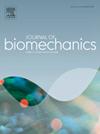使用有限螺旋轴评估椎间盘前移位患者在张口和闭口时的下颌骨运动。
IF 2.4
3区 医学
Q3 BIOPHYSICS
引用次数: 0
摘要
了解颞下颌关节(TMJ)运动学对于临床诊断和治疗颞下颌关节疾病至关重要。然而,目前还缺乏对椎间盘前移位(ADD)患者下颌骨运动信息的全面描述。有限螺旋轴(FHA)是一种描述刚体在空间运动的数学模型。该模型通过区分围绕 FHA 轴的旋转和沿 FHA 轴的平移来量化下颌骨的运动模式。本研究旨在利用 FHA 比较注意力缺失症患者和无症状受试者在张口和闭口时的下颌骨运动模式。研究人员使用光学运动跟踪系统对 10 名无症状受试者(2 名女性和 8 名男性,年龄 19-22 岁)和 10 名注意力缺失症患者(8 名女性和 2 名男性,年龄 19-57 岁)的张闭嘴动作进行了跟踪。根据运动轨迹确定张口和闭口时的 FHA。进一步计算了从髁突中心到 FHA 的距离(dCP)、FHA 与头部坐标系之间的角度(θx、θy、θz)以及 FHA 空间方位的全局波动(θf)。此外,还计算了每一帧相对于初始帧的螺旋轴,以确定张口和闭口时下颌骨运动的最大旋转角度(Θmax)和最大偏移量(Tmax)。结果发现,注意力缺失症患者的 Θmax、Tmax、dLCPmean、dLCPmin、θx 和 θf 与无症状受试者有显著差异。这些发现表明,FHA 能有效地描述注意力缺失症患者与无症状者之间的差异。本文章由计算机程序翻译,如有差异,请以英文原文为准。
Evaluation of mandibular motions in patients with anterior disc displacement during mouth opening and closing using finite helical axis
Understanding temporomandibular joint (TMJ) kinematics is essential for the clinical diagnosis and treatment of TMJ disorders. Yet, a comprehensive description of mandibular motion information in patients with anterior disc displacement (ADD) is lacking. The finite helical axis (FHA) is a mathematical model describing the motion of a rigid body in space. This model quantifies mandibular motion patterns by differentiating between rotation around the FHA and translation along it. This study aimed to compare the mandibular motion patterns between patients with ADD and asymptomatic subjects during mouth opening and closing utilizing the FHA. Ten asymptomatic subjects (2 females and 8 males, aged 19–22) and ten patients with ADD (8 females and 2 males, aged 19–57) were tracked using an optical motion tracking system for mouth opening and closing. The FHA during mouth opening and closing was determined from motion trajectory. The distance from the condylar center to the FHA (dCP), the angles between the FHA and the head coordinate system (θx, θy, θz), and the global fluctuation of the FHA spatial orientation (θf) were further calculated. In addition, the helical axis of each frame relative to the initial frame was computed to determine the maximum rotation angle (Θmax) and maximum offset (Tmax) of mandibular motion during mouth opening and closing. It was found that Θmax, Tmax, dLCPmean, dLCPmin, θx, and θf for patients with ADD differed significantly from those of asymptomatic subjects. These findings imply that the FHA effectively describes the disparities between patients with ADD and asymptomatic subjects.
求助全文
通过发布文献求助,成功后即可免费获取论文全文。
去求助
来源期刊

Journal of biomechanics
生物-工程:生物医学
CiteScore
5.10
自引率
4.20%
发文量
345
审稿时长
1 months
期刊介绍:
The Journal of Biomechanics publishes reports of original and substantial findings using the principles of mechanics to explore biological problems. Analytical, as well as experimental papers may be submitted, and the journal accepts original articles, surveys and perspective articles (usually by Editorial invitation only), book reviews and letters to the Editor. The criteria for acceptance of manuscripts include excellence, novelty, significance, clarity, conciseness and interest to the readership.
Papers published in the journal may cover a wide range of topics in biomechanics, including, but not limited to:
-Fundamental Topics - Biomechanics of the musculoskeletal, cardiovascular, and respiratory systems, mechanics of hard and soft tissues, biofluid mechanics, mechanics of prostheses and implant-tissue interfaces, mechanics of cells.
-Cardiovascular and Respiratory Biomechanics - Mechanics of blood-flow, air-flow, mechanics of the soft tissues, flow-tissue or flow-prosthesis interactions.
-Cell Biomechanics - Biomechanic analyses of cells, membranes and sub-cellular structures; the relationship of the mechanical environment to cell and tissue response.
-Dental Biomechanics - Design and analysis of dental tissues and prostheses, mechanics of chewing.
-Functional Tissue Engineering - The role of biomechanical factors in engineered tissue replacements and regenerative medicine.
-Injury Biomechanics - Mechanics of impact and trauma, dynamics of man-machine interaction.
-Molecular Biomechanics - Mechanical analyses of biomolecules.
-Orthopedic Biomechanics - Mechanics of fracture and fracture fixation, mechanics of implants and implant fixation, mechanics of bones and joints, wear of natural and artificial joints.
-Rehabilitation Biomechanics - Analyses of gait, mechanics of prosthetics and orthotics.
-Sports Biomechanics - Mechanical analyses of sports performance.
 求助内容:
求助内容: 应助结果提醒方式:
应助结果提醒方式:


